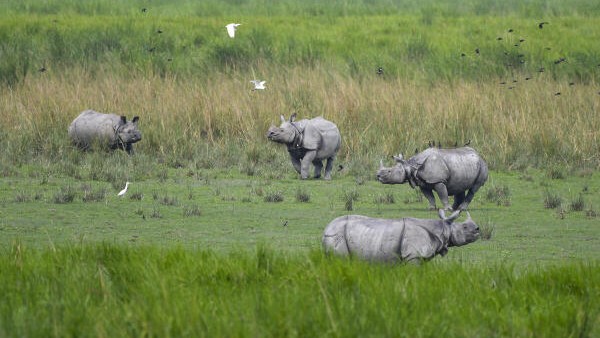
One horned rhinos graze inside the Kaziranga National Park in Assam.
Credit: PTI Photo
The famous Kaziranga in Assam is gradually moving beyond its focus on 'Big Five' wildlife and trying to explore the richness of its other biodiversity to offer varieties to visitors.
From birds to butterflies, frogs to fishes and orchids to insects, the Kaziranga National Park and Tiger Reserve (KNPTR), spread across 1,300-odd square kilometers on the flood plains of the Brahmaputra and the Karbi Anglong hills, is trying to document and spread knowledge about the variety its ecology can offer to tourists and researchers alike.
One-horned rhinos, Royal Bengal tigers, Asian elephants, swamp deer and water buffalo, popularly called the Big Five, has been the focus for tourism and conservation. But in the past few years, the park authorities have been trying to promote its other attractions.
"Recording all kinds of species—not just the famous Big Five—is key to managing Kaziranga well. By highlighting the park’s full range of wildlife, we gain deeper insights into its ecological richness and demonstrate why every species plays a part in keeping Kaziranga’s ecosystem balanced and healthy," director of the park, Sonali Ghosh, told DH.
Fish documented in Kaziranga in Assam.
Credit: @KNPTR, Assam
Kaziranga witness maximum focus for tourism in Assam as it houses the largest population of one-horned rhinos (2,613 as per 2022 Census). The park witnessed its highest footfall of over 4.43 lakh tourists during 2024-25, emerging as the third highest national park visited by tourist after Rajasthan's Ranthambore and Periyar National Park of Kerala.
Talking about the rich variety of fish, frogs and reptiles, another official in the park said, "These unique species richness of native species of fishes and herpetofauna indicate the stronghold that Kaziranga is for providing a pristine habitat to wild fauna. The diversity of amphibians and reptiles in turn also serve as key indicators of ecosystem health that play vital roles in maintaining ecological balance."
Frog documented in Kaziranga in Assam.
Credit: @KNPTR, Assam
Along with documentation and spread of the knowledge about others attractions, the park have introduced safaris for birders, Dolphin safari on the Brahmaputra and that for butterfly and orchid lovers.
Recently, the park introduced Hemtap Hill trek located at Silimkhuwa village in the Kaziranga-Karbi Anglong landscape. "It is a six kilometers trail with an elevation range of 85 to 400 meters that offers both half-day and full-day trekking options starting from 6 AM onwards. The visitors can explore a wildlife and birding trail featuring 51 recorded species, follow ancient trade pathways, visit sacred groves and take in panoramic views of the Kaziranga landscape while also experiencing local biodiversity including Hoolock Gibbon, various deer species, leopards, and elephants, as well as engaging in community-led conservation activities, traditional Karbi culinary experiences at the Ethnic Culinary Centre served traditional cuisine of the local karbi community," Ghosh added.
Infographics: Fish species: A rapid survey recently found 77 species of freshwater fish, forming major share of Assam's 216 species of indigenous fishes.
Birds paradise: The latest bird census found 1,12,062 water and wetland-dependent birds of 124 species, putting Kaziranga among one of the major bird hubs.
Grassland birds: the first ever grassland birds census conducted recently identified 43 species, most of which are under threat in other major bird habitats in the country.
Butterfly beauties: A survey documented 446 species of butterflies, making it the second biggest hub of butterflies (among the protected areas) after Namdapha Tiger Reserve in Arunachal Pradesh. Namdapha has about 500 species of butterflies.
Rich reptiles: Kaziranga also supports 108 species of amphibians and reptiles including frogs, which is over 50 per cent of the 274+ herpetofaunal species known from Northeast.
Inspects and spiders: A new rapid survey has documented 283 species of insects and spiders in a woodland habitat of the Kaziranga tiger reserve.